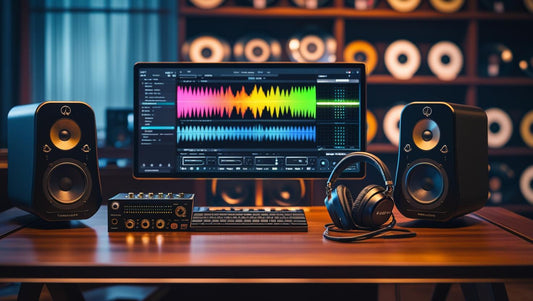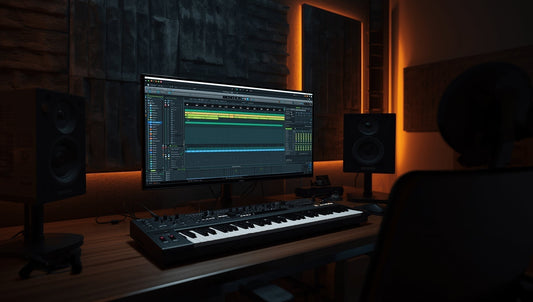Where Did Funk Music Originate?

Before funk became a sound, it was a feeling. Raw, rhythmic, and unapologetically bold, funk music didn’t just ask you to move, it made you move. With its heavy basslines, tight drums, and soulful energy, funk carved out a space that was entirely its own. But behind every groove lies a story, and funk’s story is one of culture, struggle, and creative rebellion.
Funk didn’t come out of nowhere. It was shaped by the deep roots of African-American music, born from the grit of blues, the spirit of gospel, and the swing of jazz. It found its voice during a time of social change, when artists weren’t just making music, they were making a statement. So, where did funk music really begin? Let’s trace its rhythm back to the very start.
Musical DNA and the Roots of Funk
Funk didn’t arrive on the scene as a brand-new invention, it was the result of decades of sound, soul, and cultural exchange. Its roots run deep, and its DNA is made up of powerful musical traditions that came long before the first funky bassline ever hit a stage.
1. The African Pulse Behind Funk
The heartbeat of funk can be traced back to Africa. Traditional African music emphasized polyrhythms, layered beats that loop, overlap, and sync in complex patterns. These rhythms made their way to America through enslaved Africans and became the foundation for Black American music. That deep sense of groove, the call-and-response vocals, and the communal energy you hear in funk? All of it echoes Africa’s musical spirit.
2. Where Funk Found Its Soul
As Black communities in America began to shape their own musical identities, genres like gospel, blues, and jazz became cultural lifelines. Gospel brought spiritual power. Blues brought emotional storytelling. Jazz brought improvisation and freedom. Together, they laid the emotional and musical groundwork that funk would later expand into something bolder and more rebellious.
3. Rhythm and Blues as Funk’s Ancestor
By the 1940s and ’50s, Rhythm & Blues (R&B) emerged as a powerful force in American music. It combined driving rhythms with soulful melodies, and more importantly, it introduced the groove ; a hypnotic, danceable beat that would become the backbone of funk. R&B taught funk how to move, how to feel, and how to bring rhythm to the forefront of the sound.
The Funk Revolution in the 1960s
The 1960s didn’t just witness the rise of funk — they marked a musical revolution. Funk didn’t drift in quietly; it arrived with punch, grit, and a completely new sound. This was the decade that flipped the rules, and no one led that shift more powerfully than James Brown.
1. James Brown and the Breakaway from Soul
Before he was the Godfather of Funk, James Brown was already redefining soul. But by the mid-1960s, he began stripping the music down, fewer chords, more rhythm. He brought the groove forward, putting raw energy and sharp beats at the center. It wasn’t just about melody anymore, it was about movement. Brown’s performances became electric, his band tighter, and the music leaner. This shift laid the foundation for what we now call funk.
2. “Papa’s Got a Brand New Bag” as a Funk Blueprint
Released in 1965, Papa’s Got a Brand New Bag wasn’t just a hit — it was a turning point. The track’s emphasis on rhythm over harmony, its call-and-response patterns, and its bold horn stabs created a blueprint for funk. The groove was king. The instruments weren’t just background , they were all leading the charge in layers. Brown had found “the one,” and the music world felt it.
3. Hitting “The One” and Embracing Syncopation
Funk’s rhythmic magic came from a simple but radical idea: hit the first beat of every measure hard. James Brown called it “The One.” It was a shift away from traditional rhythm structures in soul or jazz. Instead of floating or swinging, funk locked in. Combine that with syncopation — unexpected accents, off-beat patterns, space between notes and you get a groove that’s impossible to ignore. This change didn’t just alter how music sounded. It changed how it was felt.

Funk’s Founding Fathers and the Icons Who Shaped It
While James Brown may have sparked the funk revolution, it was carried forward by a wave of fearless innovators. These artists didn’t just follow a new sound, they created entire worlds around it. Funk became a vehicle for experimentation, cultural pride, and sonic exploration — and these musicians were at the front of the movement.
1. Sly and the Family Stone Blending Funk with Freedom
In the late 1960s, Sly and the Family Stone broke every mold. Their music blended funk with rock, soul, and psychedelia, and their lineup broke barriers too: Black and white, male and female, all on one stage. Tracks like Thank You (Falettinme Be Mice Elf Agin) and Dance to the Music introduced gritty basslines, punchy horns, and socially conscious lyrics wrapped in infectious grooves. Sly wasn’t just making funk ; he was making statements.
2. George Clinton and the Rise of Parliament-Funkadelic
If James Brown laid the bricks, George Clinton built a cosmic empire on top. With his twin collectives ; Parliament and Funkadelic; Clinton fused funk with heavy doses of psychedelia, sci-fi, and surreal storytelling. His live shows were theatrical, his costumes wild, and his music absolutely uncontainable. Songs like FlashLight and Give Up the Funk expanded the genre’s possibilities, turning funk into an interstellar experience.
3. The Meters and the Blueprint for Funk’s Groove
In New Orleans, The Meters were quietly revolutionizing rhythm. Their stripped-down, instrumental-heavy style focused purely on tight grooves and syncopated drums. Led by drummer Zigaboo Modeliste and guitarist Leo Nocentelli, they brought a raw, street-level energy to funk. Their influence can be heard in countless hip-hop samples, R&B grooves, and modern funk revivals. If you want to understand the “feel” of funk, The Meters are where you start.
4. Regional Scenes and Unsung Innovators
Beyond the big names were regional pockets of funk, each adding its own flavor. Dayton, Ohio became a hub for funk bands like Zapp. Los Angeles brought a polished, West Coast edge. Detroit added grit and urgency. And countless local artists helped shape the culture with underground hits, live shows, and community-driven sound. Funk wasn’t just a genre, it was a movement, and everyone contributed to the wave.

Funk’s Expansion Across the 1970s and Beyond
By the time the 1970s rolled in, funk was no longer just a sound bubbling underground — it had become a cultural force. With its magnetic rhythm and fearless energy, funk leapt into the mainstream, evolved into new sub-genres, and laid the groundwork for the next generation of music movements.
1. Funk Finds Its Place in the Mainstream
The 1970s marked the golden age of funk. Artists like Earth, Wind & Fire, Kool & The Gang, and The Ohio Players were dominating charts and selling out arenas. Funk was no longer confined to niche audiences, it was on TV, in films, and filling dance floors across America. The music brought people together with its infectious grooves, high-energy horns, and messages of empowerment and celebration. Funk had become more than a sound — it was a shared experience.
2. Branching Out into Electro-Funk and Disco-Funk
As funk matured, it started to diversify and innovate. In the late '70s and early '80s, artists began experimenting with synthesizers, drum machines, and electronic textures. This gave birth to electro-funk, popularized by acts like Zapp & Roger and Midnight Star, funk with a digital heartbeat. At the same time, disco-funk emerged, blending funk’s rhythm with disco’s glamour and four-on-the-floor pulse. Bands like Chic and Shalamar bridged the two worlds, bringing funk into dance clubs with style and elegance.
3. The Blueprint for Hip-Hop and Modern R&B
Funk didn’t just survive the transitions of music; it influenced the creation of entirely new genres. In the early 1980s, hip-hop producers began digging into crates of funk records, sampling grooves from Parliament, The Meters, and James Brown. These loops became the backbone of classic rap tracks. Funk’s DNA is also woven deep into modern R&B , from the slick basslines of D’Angelo and Anderson .Paak to the rhythmic smoothness of Bruno Mars. Even decades later, the funk is still alive , just dressed in new clothes.
More Than Music Funk’s Cultural and Social Impact
Funk wasn’t just heard, it was felt, lived, and worn. Beyond the music itself, funk became a form of expression, protest, identity, and celebration. It reflected the times, empowered communities, and reshaped the cultural landscape of America and beyond.
1. A Soundtrack to the Civil Rights Era
In the heat of the civil rights movement, funk emerged as a bold voice of Black empowerment. Artists used the groove not just to entertain, but to speak out. James Brown’s Say It Loud – I’m Black and I’m Proud became an anthem of self-pride and resistance. Funk gave people rhythm to march to, to dance to, and to rise with. In a time of division, it offered unity, pride, and presence — without apology.
2. Defining the Dance Floor and Nightlife Culture
Funk transformed nightlife. Its rhythmic foundation gave rise to a new era of dance culture, where movement became liberation. From basement parties in urban neighborhoods to iconic dance clubs in New York and LA, funk gave people permission to let loose, express themselves, and connect. The genre helped set the stage for the disco movement, breakdancing culture, and even the club scenes that dominate today.
3. Style That Spoke Volumes
Funk wasn’t just in the sound, it was in the fashion, art, and attitude. Think bold prints, flared pants, platform shoes, and afro picks raised like fists. It was expressive, rebellious, and undeniably cool. Funk culture encouraged people to embrace who they were, unapologetically. That spirit echoed in street art, poster design, album covers, and even political movements. It was a full-body, full-soul experience.
Funk’s Lasting Influence in Today’s Music
Though decades have passed since its birth, funk’s heartbeat never faded, it simply evolved. Today, you’ll find its fingerprints all over modern music, from chart-topping R&B hits to underground hip-hop and international electronic scenes. Funk isn’t a thing of the past — it’s a timeless foundation that keeps inspiring new generations of sound.
1. Neo-Soul Vibes and the Funk Revival
Artists like D’Angelo, Erykah Badu, Anderson .Paak, and Silk Sonic have brought funk’s soul and groove into the modern spotlight. Their music isn’t a copy of the past, it’s a tribute, infused with emotion, attitude, and updated flair. These artists carry funk’s DNA into the future, blending its signature rhythm with neo-soul’s intimacy and R&B’s polish. Meanwhile, funk revival bands like Vulfpeck and Lettuce prove that live funk is still very much alive, and still impossible not to move to.

2. Funk’s Flavor in Rock and Global Sounds
Funk’s influence stretches far beyond soul. Rock legends like Red Hot Chili Peppers and Prince infused their music with funk’s grit and groove. Electronic producers borrow its basslines, syncopation, and layered rhythms to create dancefloor anthems. Across the globe, funk has morphed into styles like Afrobeat, Brazilian funk, and French house, proving its language of rhythm speaks across cultures and continents.
3. Sampling That Keeps the Groove Alive
Hip-hop owes a deep debt to funk. In the early days of rap, producers like Dr. Dre, DJ Premier, and the Bomb Squad mined funk records for drum breaks, basslines, and vocal shouts. Sampling became a bridge between eras, and funk became the soul behind the beat. Even now, modern hip-hop tracks echo the groove-heavy loops of Parliament, James Brown, and The Meters, keeping the legacy alive one beat at a time.
Bring the Funk to Your Tracks with 12 Bit Soul
Funk isn’t just a sound of the past — it’s fuel for the future. If you're inspired by the rhythm, soul, and raw groove woven through this story, it's time to bring that energy into your own productions.
At 12 Bit Soul, we’ve crafted authentic funk drum kits that capture the grit, swing, and analog character of the genre’s golden age. Whether you're chopping samples or building beats from scratch, our kits give you that crunchy, soulful backbone your tracks have been missing.
-
Handcrafted analog drum sounds
-
Inspired by James Brown, The Meters, Parliament, and beyond
-
Designed for hip-hop, R&B, funk, soul, and lo-fi production
-
Instantly downloadable and ready to groove
FAQs
What makes funk different from jazz or R&B?
Funk focuses more on rhythm and groove, while jazz highlights improvisation and R&B leans on melody and emotion.
How did funk impact the music industry in the 1970s?
It brought rhythmic innovation, influenced genres like disco and hip-hop, and reshaped dance music and pop culture.
Where did funk get its signature groove sound?
From African rhythms, syncopated basslines, and emphasizing the first beat — known as “the one.”
Was funk connected to cultural or political movements?
Yes, it was a voice for Black pride and protest during the civil rights and Black Power movements.
Did funk originate in a specific U.S. city?
Not one city, but major hubs included Cincinnati, New Orleans, and Oakland, each shaping its early sound.
Who were the most influential early funk bands?
James Brown, Sly and the Family Stone, Parliament-Funkadelic, and The Meters led the movement.
Funk’s story is one of rhythm, resistance, and reinvention. Born from deep cultural roots and shaped by pioneers who dared to break the mold, it evolved from raw basement grooves into a global sound that still moves people today. From the African pulse and gospel grit to the electric energy of the 1970s and its echoes in modern music, funk has never stopped evolving , or inspiring.
Its impact isn’t just musical. Funk gave voice to movements, shaped communities, and redefined what it meant to be bold, expressive, and unapologetically original. And though decades have passed, the spirit of funk is still alive , pulsing through every beat that dares to be different.
No comments








0 comments